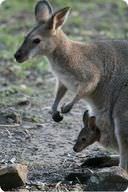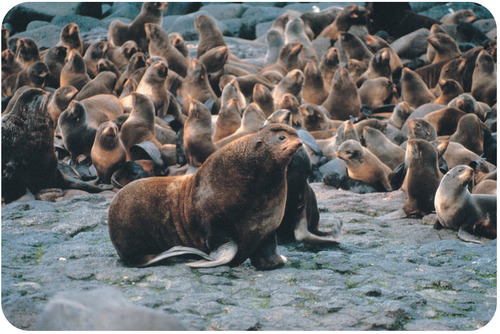10.21 哺乳动物生殖
章节大纲
-
Do mammals lay eggs ?
::哺乳动物产卵吗?Could a rabbit really lay eggs? Rabbits are mammals, and most mammals do not lay eggs. Mammals usually give birth to live offspring . But there are some mammals that do lay eggs.
::兔子真的能产卵吗?兔子是哺乳动物,大多数哺乳动物不产卵。哺乳动物通常生出活的后代。但有些哺乳动物会产卵。Mammal Reproduction
::哺乳期生殖You probably realize that cats, dogs, people, and other mammals don't typically lay eggs. There are exceptions, however. Egg-laying is possible among the , mammals with birdlike and reptilian characteristics. Recall that mammals can be classified into three general groups, based on their reproductive strategy: the monotremes, the and the .
::你可能意识到猫、狗、人和其他哺乳动物通常不会产卵。不过,也有例外。在有鸟类和爬行动物特征的哺乳动物中,可以进行蛋类繁殖。请注意,哺乳动物可以根据其生殖策略分为三大类:单体、单体和单体。The egg-laying monotremes, such as echidnas ( Figure ) and platypuses ( Figure ), use one opening, the cloaca , to urinate, release waste, and reproduce, just like . They lay leathery eggs, similar to those of lizards, , and crocodilians. Monotremes feed their young by “sweating” milk from patches on their bellies, as they lack the nipples present on other mammals.
::产卵单体,如树脂(echidnas)和白喉(figure ) , 使用一个开口(cloaca)来撒尿、释放废物和繁殖,就像 。它们像蜥蜴一样产下皮质鸡蛋,和鳄梨一样。 单体动物从腹部的补丁中用“weating”牛奶喂养幼虫,因为它们缺乏其他哺乳动物的乳头。The echidna ( right ) is a member of the monotremes, the most primitive order of mammals. Another monotreme, the platypus ( left ), like other mammals in this order, lays eggs and has a single opening for the urinary, genital, and digestive organs.
::以希德纳(echidna)是哺乳动物最原始的单体动物。 另一种单体动物,即白喉(left ) , 与其他哺乳动物一样,向左,产卵,并为尿道、生殖器和消化器官提供一个单一的开口。All other mammals give birth to live young and belong to one of two different categories, the marsupials and the placental mammals. A marsupial is an in which the embryo , which is often called a joey, is born at an immature stage. must be completed outside the mother's body. Most female marsupials have an abdominal pouch or skin fold where there are mammary glands . The pouch is a place for completing the development of the baby. Although blind, without fur, and with only partially formed hind legs, the tiny newborns have well developed forelimbs with claws that enable them to climb their way into their mother's pouch where they drink their mother's milk and continue their development. Marsupials include kangaroos, koalas, and opossums. Other marsupials are the wallaby and the Tasmanian Devil. Most marsupials live in Australia and nearby areas. ( Figure ).
::所有其他哺乳动物都是幼年出生的,属于两种不同的类别之一,即哺乳动物和胎盘哺乳哺乳动物。哺乳动物是指胚胎,通常被称为joey,在不成熟的阶段出生,必须在母亲身体之外完成。大多数雌性哺乳动物都有腹部袋或皮肤折叠,那里有哺乳腺。邮袋是婴儿发育的产地。虽然没有毛皮,而且只有部分后腿,但幼小的新生儿发育良好,有爪子,可以爬进母亲的袋里,在那里他们可以喝母亲的牛奶,继续发育。马苏比动物包括袋鼠、鳄鱼和食肉。其他的哺乳动物是Wallaby和Tasmanian Devil。大多数的哺乳动物居住在澳大利亚和附近地区。 (Figure)。The majority of mammals are placental mammals. These are mammals in which the developing baby is fed through the mother's placenta . Female placental mammals develop a placenta after . A placenta is a spongy structure that passes oxygen, nutrients , and other useful substances from the mother to the fetus . It also passes carbon dioxide and other wastes from the fetus to the mother. allows the fetus to grow for a long time within the mother.
::大部分哺乳动物都是胎盘哺乳动物,这些哺乳动物是发育中婴儿通过母亲胎盘喂养的哺乳动物; 雌胎胎哺乳动物在母亲胎盘后形成胎盘; 胎盘哺乳动物是一种海绵结构,将氧气、营养素和其他有用物质从母亲传给胎儿; 将二氧化碳和其他废物从胎儿传给母亲; 允许胎儿在母亲体内长时期生长。A marsupial mammal, this eastern gray kangaroo has a joey (young kangaroo) in its abdominal pouch.
::这个东灰色袋鼠的腹腔袋里 装着一只小袋鼠(小袋鼠)Some mammals are alone until a female can become pregnant. Others form social groups with big differences between sexes, such as size differences, a trait called sexual dimorphism . Dominant males are those that are the largest or best-armed. These males usually have an advantage in mating . They may also keep other males from mating with females within a group. This is seen in elephant seals ( Figure ), and also with elk, lions and non-human , including the orangutans and gorillas. Male elk grow antlers, while female elk do not have antlers. Adult male lions are not only larger than females, they have a mane of long hair on the side of the face and top of the head.
::有些哺乳动物独自一人,直到雌海豹能够怀孕。另一些哺乳动物则形成两性差异很大的社会群体,如体积差异,一种称为性畸形的特征。雄性雄性雄性雄性雄性是最大的或装备最精良的。这些雄性雄性雄性雄性通常在交配方面有优势。这些雄性雄性在一组人中也可以防止其他雄性雄性与雌性交配。大象海豹(Figure ) , 大象海豹、狮子和非人类(包括猩猩和大猩猩)也可以看到这一点。雄鹿长鹿长鹿长鹿,而雌鹿长鹿长鹿长鹿,而雌性鹿长鹿长鹿长鹿,成年雄性雄性雄性雄性雄性雄性雄性雄性雄性雄性雄性雄性狮子不仅比雌性大,在脸部和头顶部长发。A mating system with a group of many females and one male, as seen in the seal species. Male elephant seals can grow to 14 feet long, whereas females can grow to 11 feet long.
::从海豹物种中可以看出,海象的交配体系由众多雌性和一男组成。 雄性大象海豹长到14英尺,而雌性海豹长到11英尺。Summary
::摘要-
Monotremes can lay eggs, but most mammals give birth to live young.
::单体动物可以产卵, 但大多数哺乳动物生下来的都是活生生的。 -
Mammals can be marsupial, where the embryo is born at an immature stage and develops in the pouch.
::哺乳动物可以是哺乳动物,胚胎在不成熟的阶段出生,在邮袋中发育。 -
Mammals can be placental, where substances are passed from the mother to the fetus so that it can stay longer in the womb.
::哺乳动物可以是胎盘,其物质从母亲传到胎儿,从而可以在子宫中停留更长的时间。
Explore More
::探索更多Use the resources below to answer the questions that follow.
::利用以下资源回答以下问题。Explore More I
::探索更多-
Marsupials
at
::立体在
-
What are four examples of marsupials?
::四个结婚仪式的例子是什么? -
Where are most marsupials found?
::在哪里发现大多数的结婚证? -
What is the primary difference between marsupial and placental mammals? Explain your response.
::哺乳动物和胎盘哺乳动物之间的主要区别是什么?请解释您的反应。
Explore More II
::探索更多情况二-
Marsupial Reproduction Process
at
(4:06)
::4:06时的火星复制过程
-
How does parental care in marsupial mammals differ from parental care in placental mammals?
::哺乳哺乳动物的父母照料与胎盘哺乳动物的父母照料有何不同? -
Why do marsupials lick themselves during birth?
::为什么要在生孩子的时候 亲手舔自己呢? -
How do scientists think marsupial babies find the pouch?
::科学家们认为 盗尸婴儿是怎么找到邮袋的?
Explore More III
::探索更多三-
Creation of Placenta
at
(3:51)
::创建(3:51)百联胎
-
What are two of the purposes of the placenta?
::胎盘有两个目的? -
What does the placenta allow to pass to the embryo?
::胎盘允许什么 传递到胚胎? -
What does the placenta keep from the embryo?
::胎盘对胚胎有什么影响? -
What is the function of the umbilical cord?
::绷带的功能是什么?
Review
::回顾-
How are monotremes more like reptiles and birds than other mammals?
::单体动物比其他哺乳动物更像爬行动物和鸟类吗? -
What's the difference between marsupial and placental animals?
::胎盘动物和胎盘动物有什么区别? -
What are three marsupials?
::三个结婚仪式是什么? -
Define and describe the role of the placenta.
::界定和描述胎盘的作用。 -
What is sexual dimorphism?
::什么是性畸形?
-
Monotremes can lay eggs, but most mammals give birth to live young.



